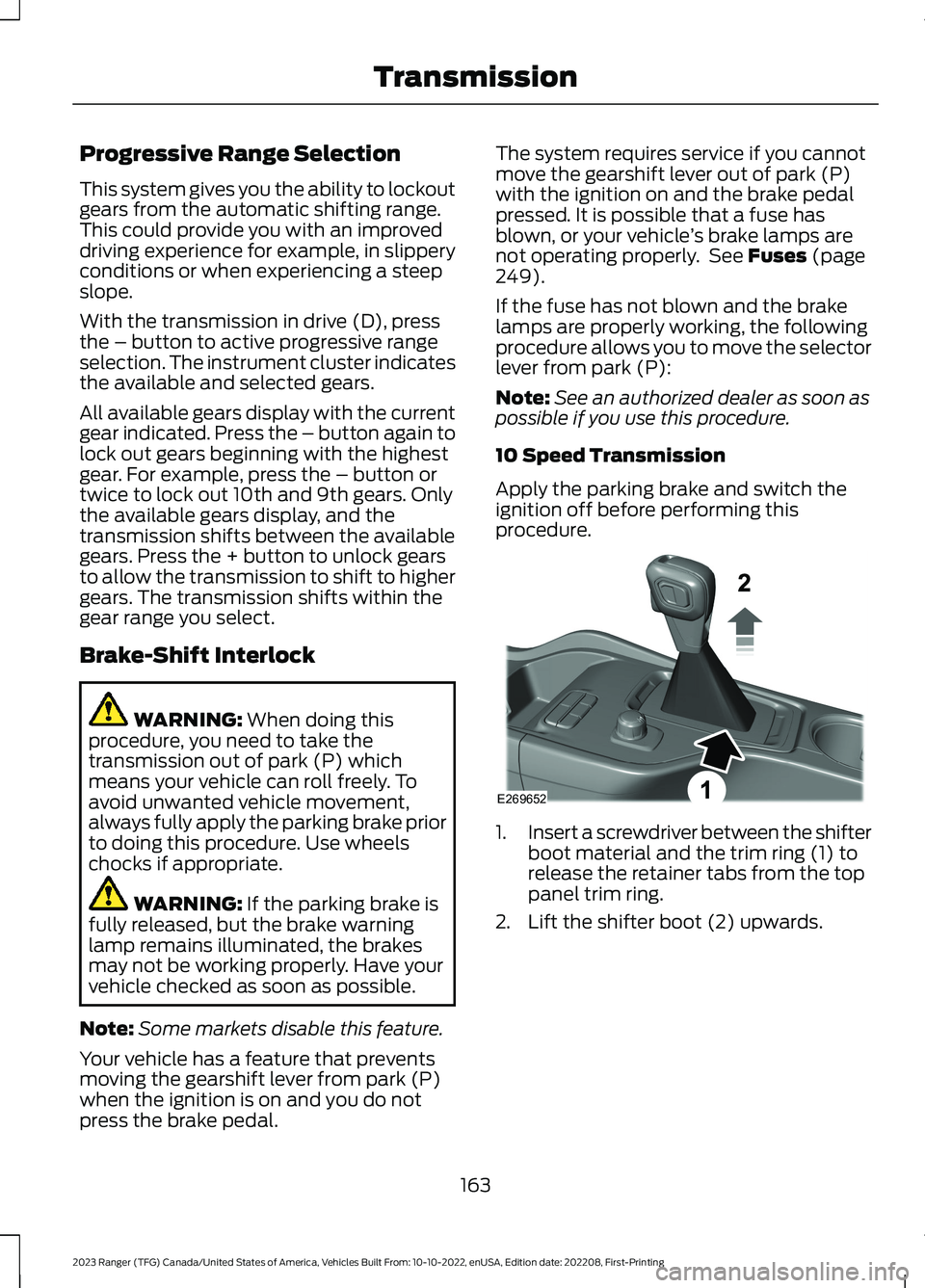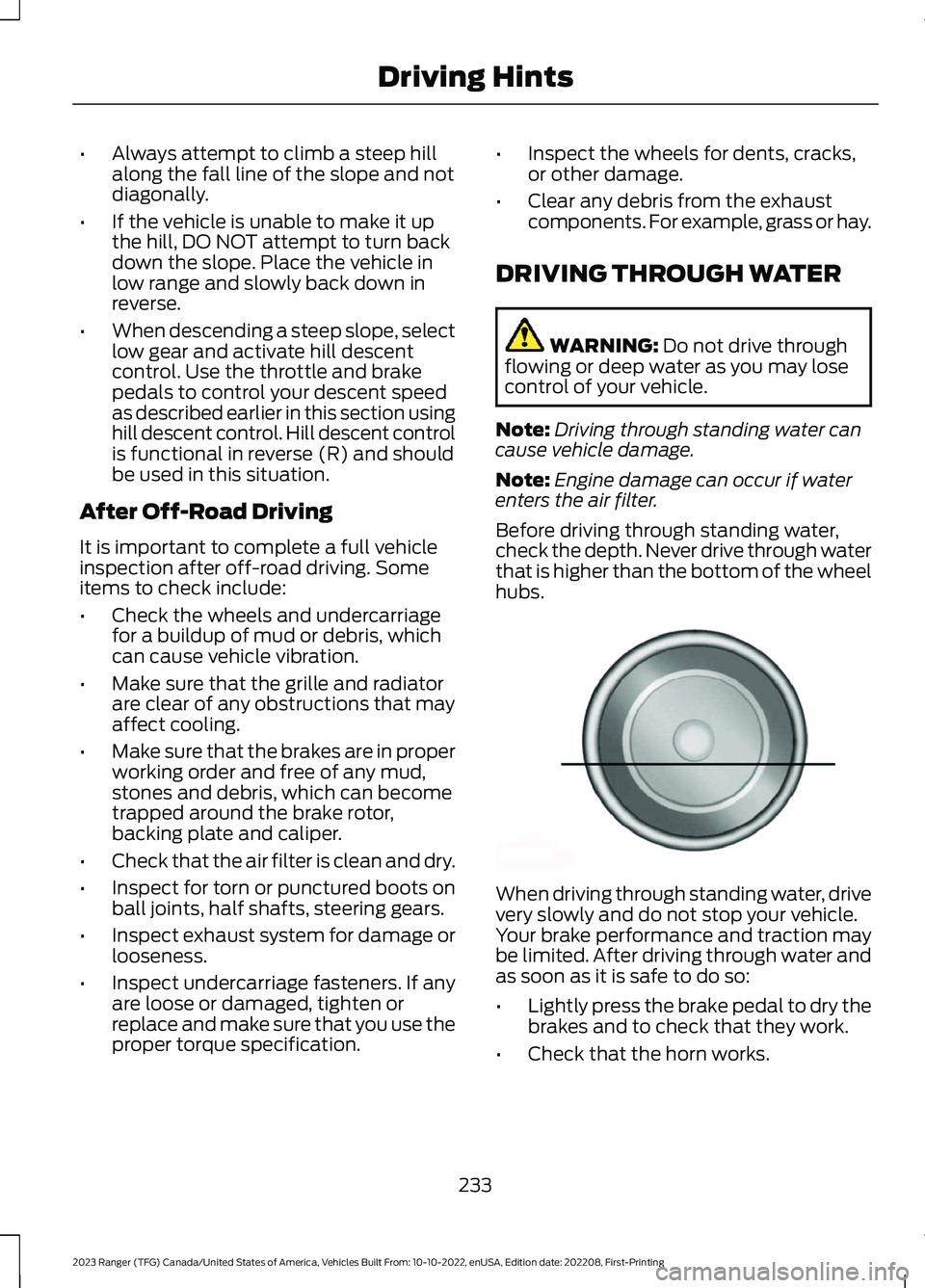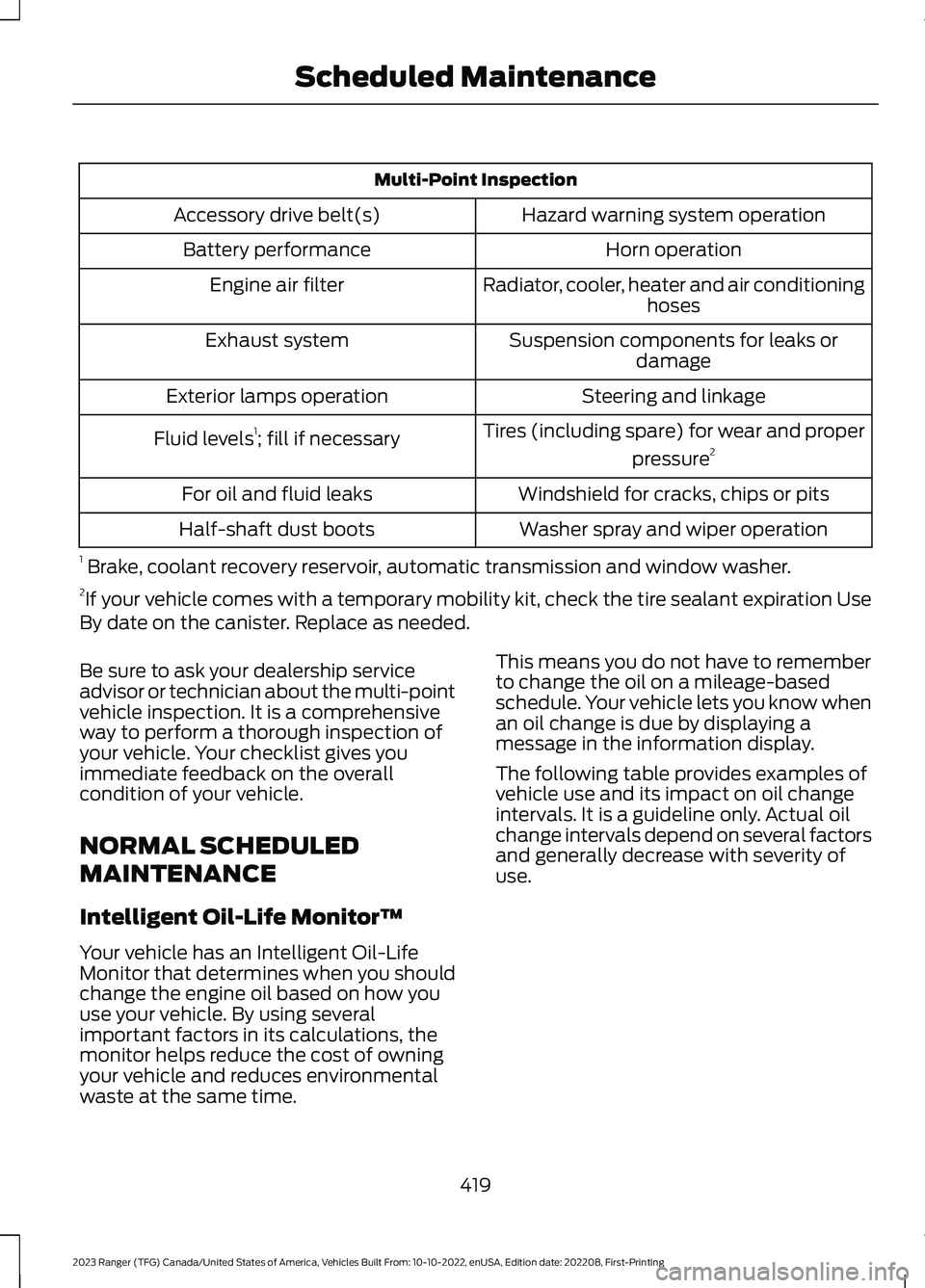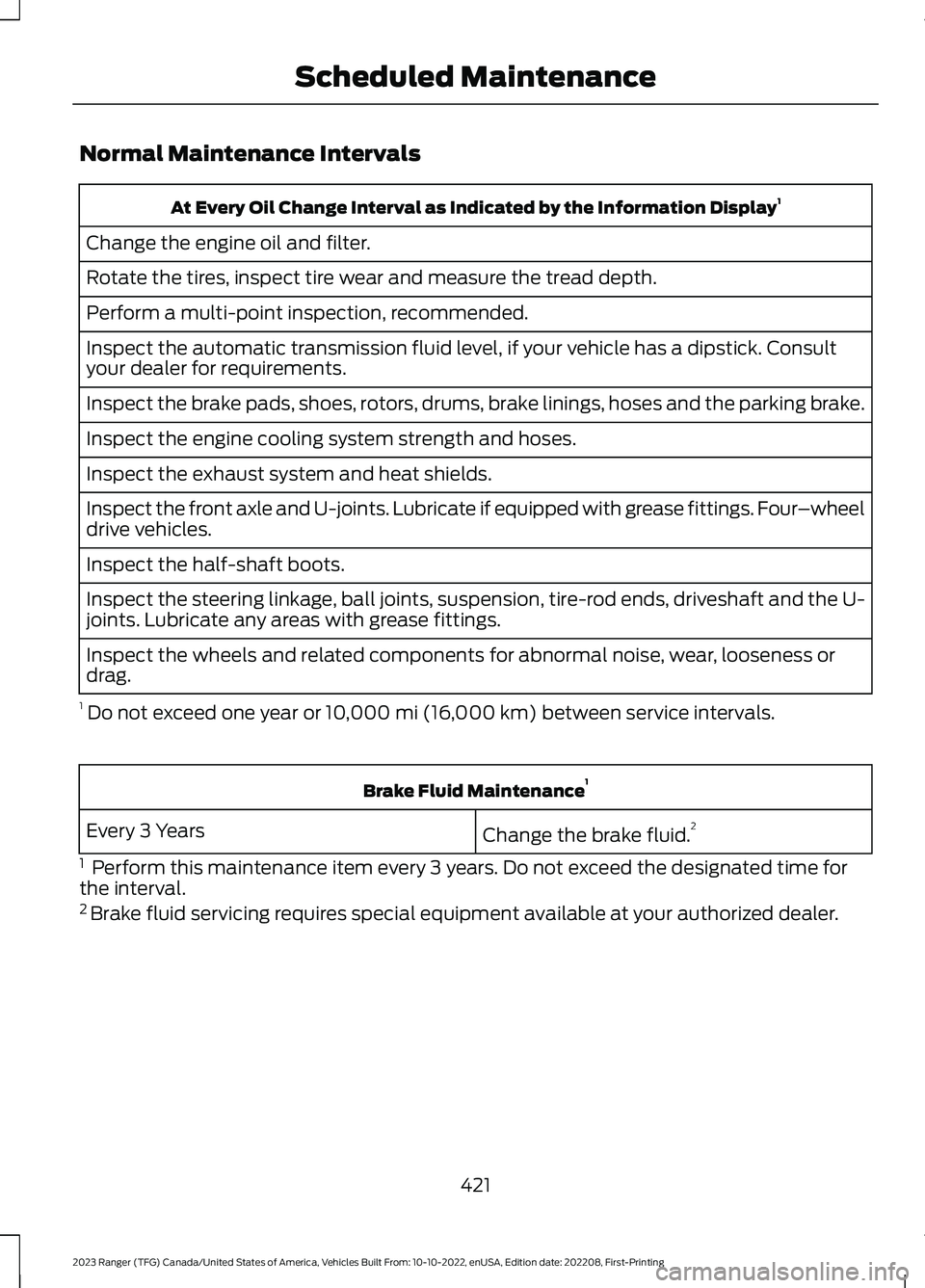boot FORD RANGER 2023 Owners Manual
[x] Cancel search | Manufacturer: FORD, Model Year: 2023, Model line: RANGER, Model: FORD RANGER 2023Pages: 470, PDF Size: 13.06 MB
Page 167 of 470

Progressive Range Selection
This system gives you the ability to lockoutgears from the automatic shifting range.This could provide you with an improveddriving experience for example, in slipperyconditions or when experiencing a steepslope.
With the transmission in drive (D), pressthe – button to active progressive rangeselection. The instrument cluster indicatesthe available and selected gears.
All available gears display with the currentgear indicated. Press the – button again tolock out gears beginning with the highestgear. For example, press the – button ortwice to lock out 10th and 9th gears. Onlythe available gears display, and thetransmission shifts between the availablegears. Press the + button to unlock gearsto allow the transmission to shift to highergears. The transmission shifts within thegear range you select.
Brake-Shift Interlock
WARNING: When doing thisprocedure, you need to take thetransmission out of park (P) whichmeans your vehicle can roll freely. Toavoid unwanted vehicle movement,always fully apply the parking brake priorto doing this procedure. Use wheelschocks if appropriate.
WARNING: If the parking brake isfully released, but the brake warninglamp remains illuminated, the brakesmay not be working properly. Have yourvehicle checked as soon as possible.
Note:Some markets disable this feature.
Your vehicle has a feature that preventsmoving the gearshift lever from park (P)when the ignition is on and you do notpress the brake pedal.
The system requires service if you cannotmove the gearshift lever out of park (P)with the ignition on and the brake pedalpressed. It is possible that a fuse hasblown, or your vehicle’s brake lamps arenot operating properly. See Fuses (page249).
If the fuse has not blown and the brakelamps are properly working, the followingprocedure allows you to move the selectorlever from park (P):
Note:See an authorized dealer as soon aspossible if you use this procedure.
10 Speed Transmission
Apply the parking brake and switch theignition off before performing thisprocedure.
1.Insert a screwdriver between the shifterboot material and the trim ring (1) torelease the retainer tabs from the toppanel trim ring.
2.Lift the shifter boot (2) upwards.
163
2023 Ranger (TFG) Canada/United States of America, Vehicles Built From: 10-10-2022, enUSA, Edition date: 202208, First-PrintingTransmissionE269652
Page 237 of 470

•Always attempt to climb a steep hillalong the fall line of the slope and notdiagonally.
•If the vehicle is unable to make it upthe hill, DO NOT attempt to turn backdown the slope. Place the vehicle inlow range and slowly back down inreverse.
•When descending a steep slope, selectlow gear and activate hill descentcontrol. Use the throttle and brakepedals to control your descent speedas described earlier in this section usinghill descent control. Hill descent controlis functional in reverse (R) and shouldbe used in this situation.
After Off-Road Driving
It is important to complete a full vehicleinspection after off-road driving. Someitems to check include:
•Check the wheels and undercarriagefor a buildup of mud or debris, whichcan cause vehicle vibration.
•Make sure that the grille and radiatorare clear of any obstructions that mayaffect cooling.
•Make sure that the brakes are in properworking order and free of any mud,stones and debris, which can becometrapped around the brake rotor,backing plate and caliper.
•Check that the air filter is clean and dry.
•Inspect for torn or punctured boots onball joints, half shafts, steering gears.
•Inspect exhaust system for damage orlooseness.
•Inspect undercarriage fasteners. If anyare loose or damaged, tighten orreplace and make sure that you use theproper torque specification.
•Inspect the wheels for dents, cracks,or other damage.
•Clear any debris from the exhaustcomponents. For example, grass or hay.
DRIVING THROUGH WATER
WARNING: Do not drive throughflowing or deep water as you may losecontrol of your vehicle.
Note:Driving through standing water cancause vehicle damage.
Note:Engine damage can occur if waterenters the air filter.
Before driving through standing water,check the depth. Never drive through waterthat is higher than the bottom of the wheelhubs.
When driving through standing water, drivevery slowly and do not stop your vehicle.Your brake performance and traction maybe limited. After driving through water andas soon as it is safe to do so:
•Lightly press the brake pedal to dry thebrakes and to check that they work.
•Check that the horn works.
233
2023 Ranger (TFG) Canada/United States of America, Vehicles Built From: 10-10-2022, enUSA, Edition date: 202208, First-PrintingDriving HintsE176913
Page 423 of 470

Multi-Point Inspection
Hazard warning system operationAccessory drive belt(s)
Horn operationBattery performance
Radiator, cooler, heater and air conditioninghosesEngine air filter
Suspension components for leaks ordamageExhaust system
Steering and linkageExterior lamps operation
Tires (including spare) for wear and proper
pressure2Fluid levels1; fill if necessary
Windshield for cracks, chips or pitsFor oil and fluid leaks
Washer spray and wiper operationHalf-shaft dust boots
1 Brake, coolant recovery reservoir, automatic transmission and window washer.2If your vehicle comes with a temporary mobility kit, check the tire sealant expiration UseBy date on the canister. Replace as needed.
Be sure to ask your dealership serviceadvisor or technician about the multi-pointvehicle inspection. It is a comprehensiveway to perform a thorough inspection ofyour vehicle. Your checklist gives youimmediate feedback on the overallcondition of your vehicle.
NORMAL SCHEDULED
MAINTENANCE
Intelligent Oil-Life Monitor™
Your vehicle has an Intelligent Oil-LifeMonitor that determines when you shouldchange the engine oil based on how youuse your vehicle. By using severalimportant factors in its calculations, themonitor helps reduce the cost of owningyour vehicle and reduces environmentalwaste at the same time.
This means you do not have to rememberto change the oil on a mileage-basedschedule. Your vehicle lets you know whenan oil change is due by displaying amessage in the information display.
The following table provides examples ofvehicle use and its impact on oil changeintervals. It is a guideline only. Actual oilchange intervals depend on several factorsand generally decrease with severity ofuse.
419
2023 Ranger (TFG) Canada/United States of America, Vehicles Built From: 10-10-2022, enUSA, Edition date: 202208, First-PrintingScheduled Maintenance
Page 425 of 470

Normal Maintenance Intervals
At Every Oil Change Interval as Indicated by the Information Display1
Change the engine oil and filter.
Rotate the tires, inspect tire wear and measure the tread depth.
Perform a multi-point inspection, recommended.
Inspect the automatic transmission fluid level, if your vehicle has a dipstick. Consultyour dealer for requirements.
Inspect the brake pads, shoes, rotors, drums, brake linings, hoses and the parking brake.
Inspect the engine cooling system strength and hoses.
Inspect the exhaust system and heat shields.
Inspect the front axle and U-joints. Lubricate if equipped with grease fittings. Four–wheeldrive vehicles.
Inspect the half-shaft boots.
Inspect the steering linkage, ball joints, suspension, tire-rod ends, driveshaft and the U-joints. Lubricate any areas with grease fittings.
Inspect the wheels and related components for abnormal noise, wear, looseness ordrag.
1 Do not exceed one year or 10,000 mi (16,000 km) between service intervals.
Brake Fluid Maintenance1
Change the brake fluid.2Every 3 Years
1 Perform this maintenance item every 3 years. Do not exceed the designated time forthe interval.2 Brake fluid servicing requires special equipment available at your authorized dealer.
421
2023 Ranger (TFG) Canada/United States of America, Vehicles Built From: 10-10-2022, enUSA, Edition date: 202208, First-PrintingScheduled Maintenance